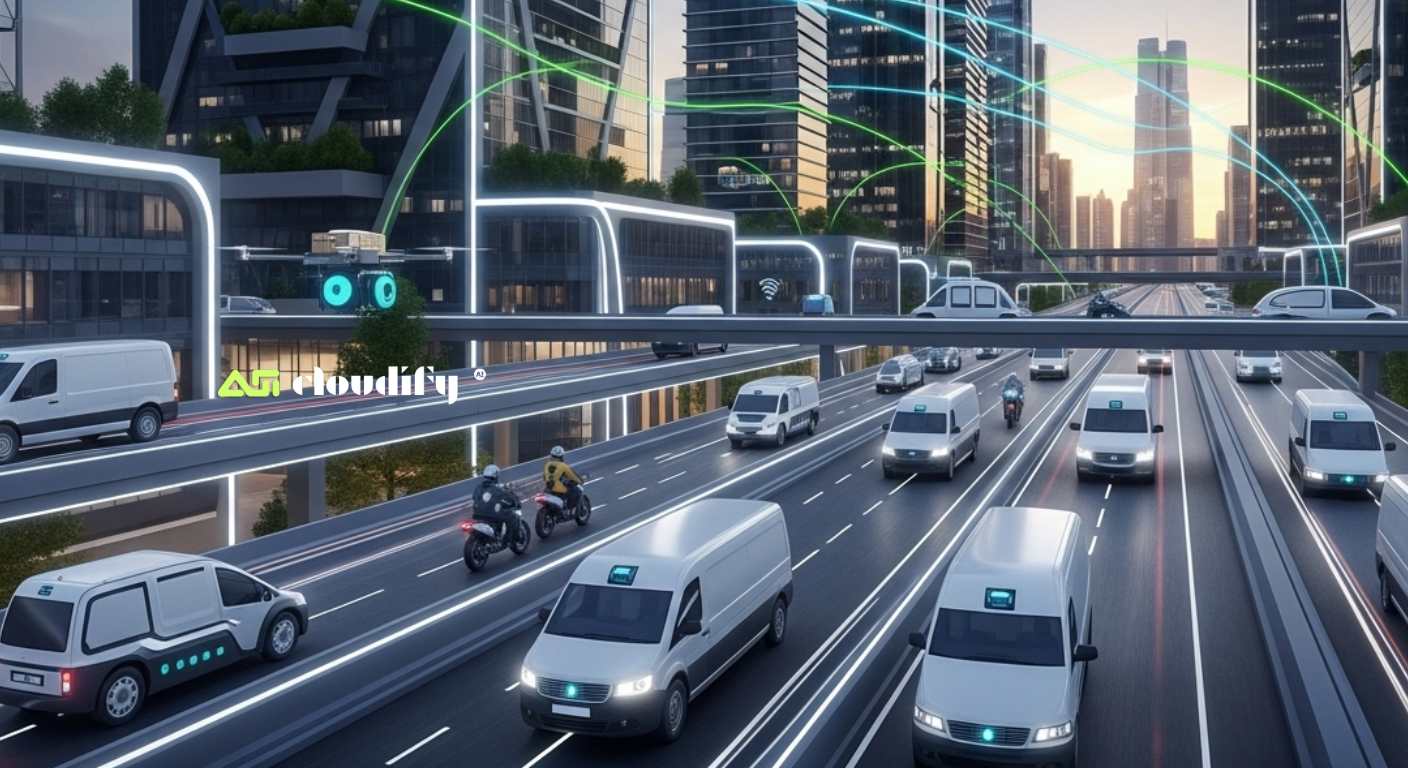In the complex and competitive ecosystem of capillary distribution, optimizing logistics and distribution processes is of vital importance. Companies are constantly seeking ways to reduce costs, increase efficiency, and improve customer experience. One of the biggest challenges in this industry is designing and managing visit routes for sales and distribution forces. Traditional routing, with its limitations and human errors, can lead to wasted time, fuel, and resources, ultimately resulting in customer dissatisfaction and reduced profit margins. This is where Artificial Intelligence (AI) enters the field as a powerful and transformative tool, bringing visit routing to an unprecedented level of optimization with a novel approach. But the main question is: Exactly how does artificial intelligence revolutionize and optimize visit routing? In this comprehensive article, we will delve deep into this topic and elucidate the mechanisms of AI's performance in capillary distribution software.
How Artificial Intelligence Optimizes Visit Routing

Introduction: Complex Challenges in the World of Capillary Distribution and Smart Solutions
In the complex and competitive ecosystem of capillary distribution, optimizing logistics and distribution processes is of vital importance. Companies are constantly seeking ways to reduce costs, increase efficiency, and improve customer experience. One of the biggest challenges in this industry is designing and managing visit routes for sales and distribution forces. Traditional routing, with its limitations and human errors, can lead to wasted time, fuel, and resources, ultimately resulting in customer dissatisfaction and reduced profit margins. This is where Artificial Intelligence (AI) enters the field as a powerful and transformative tool, bringing visit routing to an unprecedented level of optimization with a novel approach. But the main question is: Exactly how does artificial intelligence revolutionize and optimize visit routing? In this comprehensive article, we will delve deep into this topic and elucidate the mechanisms of AI's performance in capillary distribution software.

Traditional Routing: A Mountain of Challenges and Inefficiencies
Before addressing AI solutions, it is essential to look at the fundamental challenges of traditional routing methods:
- Computational Complexity: Imagine a company dealing with dozens of visitors and hundreds of customers in different areas of a large city. Manual planning, or even using simple tools, to find the optimal route (shortest, fastest, or cheapest) that covers all customers and considers all constraints, is almost computationally impossible. This challenge grows exponentially with the increasing number of visitors and customers.
- Time and Human Resource Consumption: Manual route planning is a very time-consuming process that occupies a significant portion of logistics managers' time. This time could be spent on more strategic tasks.
- Human Error: Humans are prone to error. Mistakes in calculating distances, estimating times, or overlooking minor constraints can lead to major deviations in planning.
- Lack of Flexibility: The real world is full of unexpected events: sudden traffic, accidents, order cancellations, or urgent order requests from a new customer. Traditional systems cannot quickly adapt to these changes and require manual revisions, which is time-consuming and inefficient.
- Ignoring Multiple Variables: An optimal route does not only depend on distance. Other factors such as vehicle load capacity, visitor working hours, time constraints for delivery or customer meetings, customer prioritization, and even specific visitor skills (e.g., for selling specific products) must be considered simultaneously. Managing these variables simultaneously is difficult for humans.

Artificial Intelligence: How it Changes the Game?
Capillary distribution software enhanced with AI capabilities, instead of relying on guesswork or simple calculations, uses complex algorithms, Machine Learning, and optimization to solve the aforementioned challenges. Below, we will discuss the main mechanisms of this transformation:
Gathering and Analyzing Big and Multifaceted Data
Artificial intelligence requires data. An intelligent routing system collects and analyzes a huge volume of data from various sources:
- Geographical and Traffic Data: Detailed maps, real-time traffic information from services like Google Maps or Waze, information about legal speeds on roads, restrictions on entry and exit to specific areas.
- Customer Data: Precise geographical location of each customer, their working hours and time preferences, volume and type of previous and current orders, sales history, strategic importance of the customer, special needs (e.g., need for a refrigerated vehicle).
- Fleet and Visitor Data: Number and type of available vehicles (pick-up, light truck, motorcycle), load capacity of each vehicle, fuel consumption, working hours of visitors/drivers, skills and specialties of each visitor.
- Environmental Data: Weather conditions, special events (such as festivals or demonstrations that can block routes).
Artificial Intelligence Example: Suppose AI is processing urban traffic data. Instead of just looking at average speed, the system can use Deep Learning models and analyze traffic patterns on similar days to predict what traffic will be like on a specific street at a specific hour and include this prediction in travel time calculation, even if real-time traffic has not yet peaked at that moment.
Advanced Optimization Algorithms
The core of artificial intelligence in routing is complex optimization algorithms such as Genetic Algorithms, Particle Swarm Optimization, or mathematical programming methods. These algorithms can evaluate millions of possible route combinations in fractions of a second and choose the best one.
- Solving the Traveling Salesperson Problem (TSP): This is one of the classic problems in computer science, aiming to find the shortest possible route that visits each "city" (customer) exactly once and returns to the origin city. AI solves more complex versions of this problem by considering more variables.
- Vehicle Routing Problem (VRP): This is an extended TSP problem where multiple vehicles with different capacities, from one or more depots, are used to serve a group of customers with different demands. AI, by considering all these factors, performs the optimal allocation of vehicles to routes and the sequence of visits.
Artificial Intelligence Example: The AI system can use genetic algorithms to create a set of "generations" of probable routes. Then, each generation is "scored" based on criteria such as shortest time, shortest distance, or lowest cost. The best routes are "selected," "mutated," and "combined" to create new generations of better routes. This process is repeated millions of times to eventually reach the closest possible optimal state.
Machine Learning for Prediction and Continuous Improvement
AI systems do not only make decisions based on existing data but also learn from the past and improve themselves.
- More Accurate Traffic Prediction: By analyzing past traffic data at different times and days, AI can identify traffic patterns and provide more accurate predictions of which route will be busy at what time.
- Improved Visit Time Estimation: By monitoring the actual time spent on each visit in the past, the system can more accurately estimate the time required for future visits and incorporate this data into subsequent planning.
- Identifying Inefficiency Patterns: AI can identify patterns in visitor or route performance that lead to inefficiencies and offer suggestions for improvement.
Artificial Intelligence Example: Suppose AI notices that visitor X in area A always spends 15 minutes more than the average for each visit. The system can, in future planning, allocate more time for his visits in that area or even provide suggestions for training or changing the approach for visitor X. Also, if an area consistently experiences unexpected traffic, the system can learn this pattern and suggest alternative routes in the future.
Real-time Dynamic Optimization
One of the biggest advantages of artificial intelligence is its ability to react quickly to changes.
- Reaction to Traffic Changes: If unexpected traffic occurs on a route, the system automatically suggests an alternative route.
- Managing New or Canceled Orders: With the addition of an urgent order or the cancellation of a visit, AI quickly re-evaluates the remaining routes and provides the optimal plan to minimize disruption.
- Fleet Problems: In case of a vehicle breakdown or driver delay, the system can adjust the routes of other visitors to ensure all customers are still covered.
Artificial Intelligence Example: A visitor is driving to their third customer when the system suddenly alerts that the main road is blocked. At that moment, AI, by analyzing traffic conditions and other visitors, suggests an alternative route to the visitor and, if necessary, adjusts the sequence of his subsequent visits and even other visitors in that area to ensure the entire system continues to operate with minimal delay and cost.

A Smart Future for Capillary Distribution
Artificial intelligence in capillary distribution software is no longer a futuristic concept; it is a practical and powerful tool that can transform your business today. By leveraging the unparalleled capabilities of AI, you can not only save time, fuel, and costs, but also increase customer satisfaction by providing better and more accurate services, ultimately leading to greater profitability. This technology paves the way for a smart, efficient, and flexible capillary distribution system.
Are you ready to transform your capillary distribution business with the power of artificial intelligence and benefit from its competitive advantages? To learn more and experience the intelligent power of AseCloudify capillary distribution, developed with the latest AI technologies, visit our landing page today and request a free demo of our capillary distribution software! With AseCloudify, experience the future of capillary distribution today.



